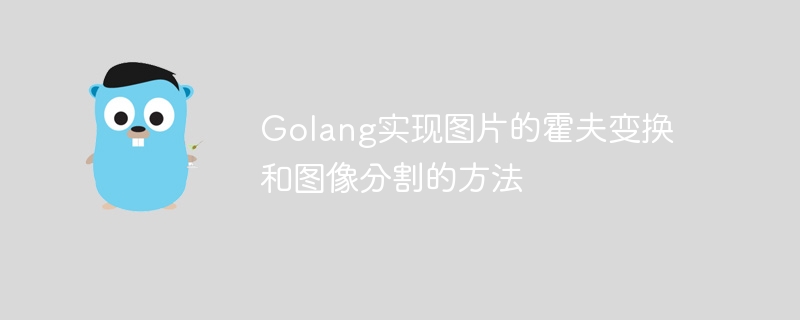Heim >Backend-Entwicklung >Golang >Golang implementiert die Hough-Transformation und Bildsegmentierung von Bildern
Golang implementiert die Hough-Transformation und Bildsegmentierung von Bildern
- 王林Original
- 2023-08-22 14:04:501303Durchsuche

Golangs Methode zur Implementierung der Hough-Transformation und Bildsegmentierung von Bildern
Zusammenfassung:
In diesem Artikel wird die Methode zur Verwendung der Golang-Programmiersprache zur Implementierung der Hough-Transformation und Bildsegmentierung von Bildern vorgestellt. Die Hough-Transformation ist eine häufig verwendete Bildverarbeitungstechnik zur Erkennung spezifischer geometrischer Formen wie Linien und Kreise. Wir werden zunächst die Grundprinzipien der Hough-Transformation vorstellen und dann Golang verwenden, um die Hough-Transformations- und Bildsegmentierungsalgorithmen zu implementieren und entsprechende Codebeispiele zu geben.
- Grundprinzip der Hough-Transformation
Hough-Transformation ist eine Technik zur Erkennung spezifischer geometrischer Formen in Bildern. Bei der Hough-Transformation finden wir diese geometrischen Formen im Bild, indem wir jedes Pixel des Bildes durchlaufen und Kurven akkumulieren, die bestimmten geometrischen Formen im Parameterraum entsprechen. Zur Erkennung gerader Linien wird der Parameterraum üblicherweise in Form von Polarkoordinaten ausgedrückt. - So implementieren Sie die Hough-Transformation und Bildsegmentierung in Golang
2.1 Importieren Sie verwandte Bibliotheken
Zuerst müssen wir die relevanten Bildverarbeitungsbibliotheken in Golang importieren. Das Folgende ist ein Codebeispiel:
import (
"image"
"image/color"
"image/png"
"math"
"os"
)2.2 Implementieren Sie die Hough-Transformationsfunktion
Das Folgende ist ein einfaches Funktionsbeispiel zum Implementieren der Hough-Transformation:
func houghTransform(img image.Image) [][]int {
bounds := img.Bounds()
width, height := bounds.Max.X, bounds.Max.Y
// 初始化霍夫空间
maxRho := int(math.Sqrt(float64(width*width + height*height)))
houghSpace := make([][]int, 180)
for i := range houghSpace {
houghSpace[i] = make([]int, maxRho*2)
}
// 遍历图像的每一个像素点
for x := 0; x < width; x++ {
for y := 0; y < height; y++ {
c := color.GrayModel.Convert(img.At(x, y)).(color.Gray)
if c.Y > 128 {
// 如果像素点的灰度值大于阈值,进行霍夫变换
for theta := 0; theta < 180; theta++ {
rho := int(float64(x)*math.Cos(float64(theta)*math.Pi/180) + float64(y)*math.Sin(float64(theta)*math.Pi/180))
houghSpace[theta][rho+maxRho]++
}
}
}
}
return houghSpace
}2.3 Bildsegmentierungsfunktion implementieren
Das Folgende ist ein einfaches Funktionsbeispiel zum Implementieren der Bildsegmentierung:
func segmentImage(img image.Image, houghSpace [][]int, threshold int) image.Image {
bounds := img.Bounds()
width, height := bounds.Max.X, bounds.Max.Y
out := image.NewRGBA(bounds)
// 遍历图像的每一个像素点
for x := 0; x < width; x++ {
for y := 0; y < height; y++ {
c := color.GrayModel.Convert(img.At(x, y)).(color.Gray)
if c.Y > 128 {
// 如果像素点的灰度值大于阈值,根据所属的曲线进行分割
for theta := 0; theta < 180; theta++ {
rho := int(float64(x)*math.Cos(float64(theta)*math.Pi/180) + float64(y)*math.Sin(float64(theta)*math.Pi/180))
if houghSpace[theta][rho+len(houghSpace[theta])/2] > threshold {
out.Set(x, y, color.RGBA{255, 255, 255, 255})
break
}
}
}
}
}
return out
}- Rufen Sie die Funktion auf und geben Sie das Ergebnis aus
Das Folgende ist ein Beispiel Verwendung:
func main() {
// 读入原始图像
file, _ := os.Open("input.png")
defer file.Close()
img, _ := png.Decode(file)
// 进行霍夫变换
houghSpace := houghTransform(img)
// 进行图像分割
out := segmentImage(img, houghSpace, 100)
// 保存结果图像
outFile, _ := os.Create("output.png")
defer outFile.Close()
png.Encode(outFile, out)
}Im obigen Beispiel haben wir zuerst ein Originalbild eingelesen, dann eine Hough-Transformation und Bildsegmentierung daran durchgeführt und das Ergebnis in einem neuen Bild gespeichert.
Zusammenfassung:
Hough-Transformation ist eine häufig verwendete Bildverarbeitungstechnik, mit der bestimmte geometrische Formen erkannt werden können. In diesem Artikel wird die Methode zur Implementierung der Hough-Transformation und Bildsegmentierung von Bildern mit Golang vorgestellt und entsprechende Codebeispiele aufgeführt. Leser können entsprechende Änderungen und Anpassungen entsprechend ihren eigenen Anforderungen vornehmen. Ich hoffe, dieser Artikel kann allen helfen.
Referenzen:
[1] OpenCV-Tutorials [https://docs.opencv.org/3.4/d9/db0/tutorial_hough_lines.html](https://docs.opencv.org/3.4/ d9 /db0/tutorial_hough_lines.html)
Das obige ist der detaillierte Inhalt vonGolang implementiert die Hough-Transformation und Bildsegmentierung von Bildern. Für weitere Informationen folgen Sie bitte anderen verwandten Artikeln auf der PHP chinesischen Website!

